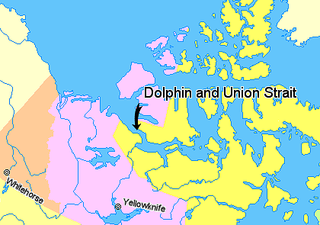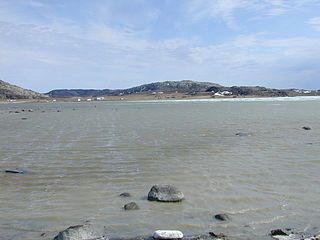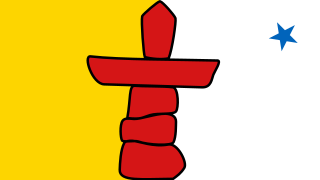
Vilhjalmur Stefansson was an Icelandic American Arctic explorer and ethnologist. He was born in Manitoba Canada, and died at the age of 82.

Diamond Jenness, was one of Canada's greatest early scientists and a pioneer of Canadian anthropology.

Dolphin and Union Strait lies in both the Northwest Territories and Nunavut, Canada, between the mainland and Victoria Island. It links Amundsen Gulf, lying to the northwest, with Coronation Gulf, lying to the southeast. The southeastern end of the strait is marked by Austin Bay. It gets its name from the two boats used by John Richardson (naturalist) who first explored it in 1826.
Blonde Eskimos or Blond Eskimos is a term first applied to sightings and encounters of light haired Inuit peoples of Northern Canada from the early 20th century, particularly around the Coronation Gulf between mainland Canada and Victoria Island. Sightings of light haired natives of the Arctic however stretch back to written accounts from the 17th century.
The Rae River (Pallirk) is a waterway that flows from Akuliakattak Lake into Richardson Bay, Coronation Gulf. Its mouth is situated northwest of Kugluktuk, Nunavut. Its shores were the ancestral home of Copper Inuit subgroups: the Kanianermiut and the Pallirmiut.
Ahiagmiut were a geographically defined Copper Inuit subgroup in the northern Canadian territory of Nunavut. They were located near Ogden Bay, on the Queen Maud Gulf, and inland towards Back River, then on towards the Akilinik River.
Ekalluktogmiut were a geographically defined Copper Inuit subgroup in Canada's Nunavut territory. They were located along the Ekalluk River near the center of Victoria Island, Albert Edward Bay in western Victoria Strait, and Denmark Bay. According to the Arctic explorer Vilhjalmur Stefansson, the Ekalluktogmiut winter hunt on Dease Strait.
Kogluktogmiut were a geographically defined Copper Inuit subgroup in the Canadian territory of Nunavut. They were located by Bloody Falls, a waterfall on the lower course of the Coppermine River in the Kugluk/Bloody Falls Territorial Park, notable for the Bloody Falls Massacre.
Sutton Island is located in northern Canada's territory of Nunavut. It is situated in the Dolphin and Union Strait immediately next to Liston/Listen Island. Rymer Point and Simpson Bay, on Victoria Island's Wollaston Peninsula are to the northeast. Bernard Harbour, on the mainland, is to the southwest, as is Chantrey Island.
The Haningayogmiut were a Copper Inuit subgroup located on the Back River (Haningayok). According to Arctic explorer Vilhjalmur Stefansson, the Haningayogmiut were a small tribe. The Kaernermiut were also located on the Back River and may have been the same subgroup.
Kaernermiut were a Copper Inuit subgroup. They were located on the Back River, and, they frequented the Thelon River. The Kaernermiut remained inland through all the seasons, coming to the sea only as single families visiting other tribes. For this reason, they did not kill seals, living instead on caribou and muskoxen. Their land was east and south of the Ahiagmiut. Because the Haningayogmiut were in the same general area, they may have been the same people, with a different name.
The Kangiryuarmiut were a Copper Inuit subgroup. They were located on Victoria Island in the areas of Prince Albert Sound, Cape Baring, and central Victoria island. They were also found around Nelson Head on Banks Island. Kangiryuarmiut subsisted on bear. They were the only Copper Inuit who built iglooit on land. The Kangiryuarmiut speak the Kangiryuarmiutun subdialect of Inuinnaqtun dialect of Inuvialuktun language.

The Umingmuktogmiut are a geographically defined Copper Inuit band in the northern Canadian territory of Nunavut, Kitikmeot Region. They were located on the western coast of Kent Peninsula, and also further south in eastern Bathurst Inlet around Everitt Point by the Barry Islands. Umingmuktogmiut were notable amongst other Copper Inuit as they had a permanent community, Umingmuktog. They could hunt and fish for Arctic char, Arctic fox, barren-ground caribou, fur seals, and muskox prevalent in the area.
The Ugyuligmiut were a geographically defined Copper Inuit band in the Canadian Arctic's Northwest Territories. They were located on Victoria Island north of Minto Inlet, and on Banks Island in the Aulavik National Park region.
The Pingangnaktok are a geographically defined Copper Inuit band in the northern Canadian territory of Nunavut, on the mainland, in Kitikmeot Region. According to Arctic explorer Vilhjalmur Stefansson's 1908-1912 ethnographic journals, they numbered about 30 at the time. In the summer, they hunted to the west of Tree River, which flows into the Coronation Gulf, where they hunted during the winter, the same as other Copper Inuit of that region.
Pallirmiut were a geographically defined Copper Inuit group in the Canadian Arctic territory of Nunavut. They were located by the mouth of the Rae River (Pallirk) during the spring. Some stayed there during summers, while others joined the Kogluktogmiut at the Bloody Falls summer salmon fishery. Pallirmiut wintered on west central Coronation Gulf, and went inland when the snow was gone, carrying packs rather than using sleds.
The Kilusiktogmiut were a Copper Inuit subgroup. They lived on Victoria Island, east of the Nagyuktogmiut who were known to inhabit the area northeast of Lady Franklin Point. They also lived on the mainland along the Coronation Gulf, particularly at the mouth of the Mackenzie River. They spent at least some time on the Banks Peninsula by Bathurst Inlet.





